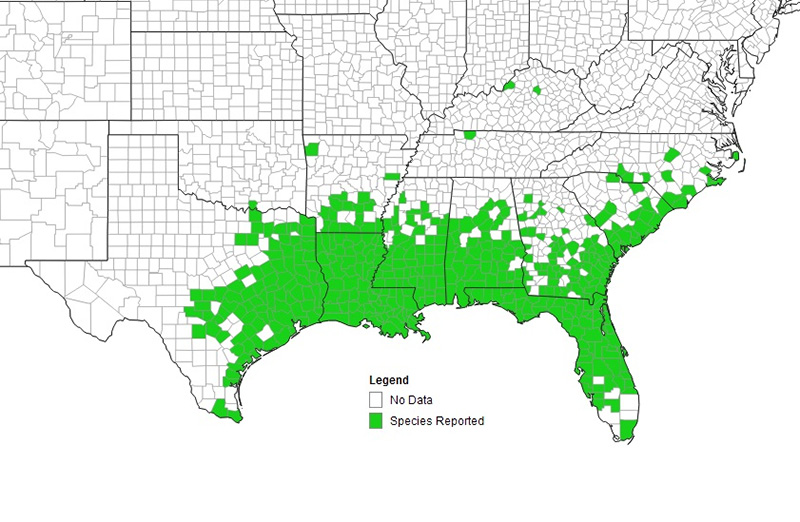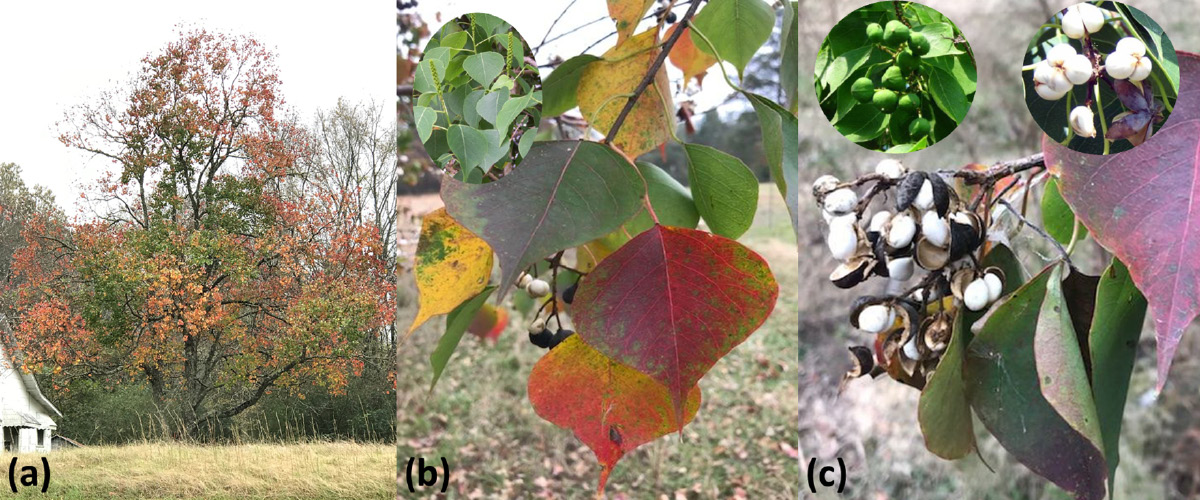Invasive Species in Pasture Systems: Chinese Tallowtree
Invasive plant species are one of the challenges that livestock producers in the South face in their pastures. The Chinese tallowtree [Triadica sebifera (L.) small] is an invasive, deciduous, upright tree that can reach up to 60 feet in height and 3 feet in diameter. This invasive species is also commonly known as the “popcorn tree” because of its distinctive fruit. The Chinese tallowtree is native to China, Japan, and Korea. It was introduced to the United States in the 1850s for ornamental purposes and seed oil production. It is considered a noxious weed in several southern states, including Florida, Louisiana, Mississippi, and Texas (Figure 1).

Chinese tallowtree is widely adapted to wet areas, such as stream banks and ditches, to drier upland areas. It can tolerate fresh to saline water-logged soils, as well as acidic to alkaline soils. It is also very competitive in both shade and full-sun conditions. This tree can displace other types of vegetation by altering soil conditions through leaf litter deposition that contains a high amount of tannins (Cameron and LaPoint, 1978; Cameron and Spencer, 1989; Pile, 2015).
This species has several unique characteristics that make it easy to identify. The Chinese tallowtree has alternately arranged, heart-shaped leaves with long, pointed tips (Figure 2). Leaves tend to be bright green in the summer. It is one of the earliest woody plants to change to fiery red in the fall. Chinese tallowtree produces long, dangling, yellow flowers from April to June. Once the flowers are pollinated, they produce a three-lobed, greenish fruit that forms clusters at the end of the branches. Once the fruit matures in September and October, it becomes dark brown to black and opens to expose the white, wax-covered seeds. This is why it is often called the “popcorn tree.” Chinese tallowtree can become reproductive in 3 years. It can produce up to 100,000 seeds per year, and its seeds have a high germination vigor. Seeds can be spread by both water and birds. The tree also spreads by producing suckers from shallow roots.

Treatments
Different treatment methods are recommended for Chinese tallowtree control. Grazing is not an option because cattle do not graze Chinese tallowtree. Goats will graze it, but they do not prefer it. Because many herbivores do not feed on this species, its invasive potential increases. Mechanical methods, such as bulldozers or forestry mulchers, will remove large, mature trees, but roots must be destroyed to prevent resprouting. Mowing saplings will force the plant to go from a single-stemmed plant to multiple stems. Burning can kill small trees, but effective use depends on having sufficient fuel for an intense fire. Several herbicides provide excellent control. Table 1 provides more information about the different types of applications, recommended herbicides, and rates. It is important to read the herbicide labels because some herbicides will damage other woody plants or forages. In addition, there may be grazing and planting restrictions for forage crops (Tables 2 and 3). Contact your local MSU Extension office for more information.
|
Application |
Herbicide |
Formulation |
Rate |
|---|---|---|---|
|
Basal |
Triclopyr |
4 lb ae/gal* |
20% solution + bark penetrator |
|
Cut-stump |
Glyphosate |
3 lb ae/gal |
1% solution |
|
Cut-stump |
Imazapyr |
2 lb ae/gal |
64 oz/ac + 32 oz water |
|
Cut-stump |
Triclopyr |
4 lb ae/gal |
undiluted |
|
Foliar |
Glyphosate |
3 lb ae*/gal |
1% solution |
|
Foliar |
Imazapyr |
2 lb ae/gal |
32 to 96 oz/ac or 2% solution |
|
Foliar |
Imazapyr + Metsulfuron |
72.70% |
25 oz/ac |
|
Foliar |
Picloram + 2,4-D |
49.80% |
128 oz/ac |
|
Foliar |
Picloram + fluroxypyr |
23.88% |
48 to 96 oz/ac |
|
Frill |
Imazapyr |
2 lb ae/gal |
64 oz/ac + 32 oz water |
|
Frill |
Triclopyr |
4 lb ae/gal |
20% solution |
|
Soil |
Hexazinone |
2 lb ai/gal |
256 to 512 oz/ac |
|
Soil |
Imazapyr |
2 lb ae/gal |
32 to 96 oz/ac or 2% solution |
*lb ae/gal = pounds of acid equivalent per gallon; lb ai/gal = pounds active ingredient per gallon. Adapted from Loewenstein and Enloe, 2015 and Maddox et al., 2017.
|
Herbicide |
Legume – Alfalfa |
Legume – Clover |
Seeded Pasture Grass – Bahia |
Seeded Pasture Grass – Bermuda |
Seeded Pasture Grass – Fescue |
Seeded Pasture Grass – Rye |
|---|---|---|---|---|---|---|
|
Glyphosate |
1w |
1w |
1w |
1w |
1w |
1w |
|
Hexazinone |
2y |
2y |
2y |
2y |
2y |
2y |
|
Imazapyr |
12m + bioassay |
12m + bioassay |
12m + bioassay |
12m + bioassay |
12m + bioassay |
12m + bioassay |
|
Metsulfuron |
bioassay |
bioassay |
ns |
ns |
fall |
fall |
|
Picloram + 2,4-D |
1y |
1y |
3w |
3w |
3w |
3w |
|
Picloram + fluroxypyr |
bioassay |
bioassay |
12m |
12m |
12m |
12m |
|
Tryclopyr |
3w |
3w |
3w |
3w |
3w |
3w |
*w = weeks; m = months; y = years; ns = next season. Source: Weed Control Guidelines for Mississippi, 2017, Publication 1532.
|
Herbicide |
Lactating – Grazing (days) |
Lactating – Haying (days) |
Nonlactating – Grazing (days) |
Nonlactating – Haying (days) |
Meat animals – Grazing (days) |
Meat Animals – Haying (days) |
Slaughter (days) |
|---|---|---|---|---|---|---|---|
|
Glyphosate |
56 |
56 |
56 |
56 |
56 |
56 |
- |
|
Hexazinone |
0 |
38 |
0 |
38 |
0 |
38 |
- |
|
Imazapyr |
0 |
7 |
0 |
7 |
0 |
7 |
- |
|
Metsulfuron |
0 |
0 |
0 |
0 |
0 |
0 |
- |
|
Picloram + 2,4-D |
7 |
30 |
0 |
30 |
0 |
30 |
3 |
|
Picloram + fluroxypyr |
14 |
7 |
0 |
7 |
0 |
7 |
3 |
|
Tryclopyr |
14 |
ns* |
0 |
7 |
0 |
7 |
3 |
*ns = next season. Source: Weed Control Guidelines for Mississippi, 2017, Publication1532.
Herbicide Application
There are several methods for applying herbicides to control Chinese tallowtrees. These methods include basal, cut-stump, foliar, frill, or soil-applied. Basal application combines the herbicide with a bark penetrant applied directly to the lower portion of the tree trunk. Basal application is frequently successful on trees that are 4 to 6 inches in diameter. It is critical to completely cover the lower 18 to 24 inches of the trunk on all sides with the herbicide mix. Treating only the side of the tree can allow for new growth to sprout on the untreated side. Basal treatments tend to be more effective in the spring before bud break, but speed of activity depends on herbicide used.
Cut-stump applications should be used on trees with stem diameters larger than 6 inches. This method prevents resprouting from the stump or lateral roots. Once the tree has been cut, remove the sawdust and immediately apply the herbicide to the cambium layer just inside the bark around the stump. In large trees, the living tissue is around the outer edge. Make sure that the outer edge is thoroughly wet, but avoid herbicide runoff. With the cut-stump method, herbicides can be applied with a backpack sprayer, squirt bottle, or paint brush. When treating a large number of stumps, it is a good idea to include a dye to mark those stumps that have been treated.
The frill application is also known as the “hack-and-squirt” technique. The method requires cutting into the bark and sapwood (cambium layer) of the tree and applying the herbicide to the cut area. An ax, hatchet, machete, or saw can be used to create the hack. The hacks should be made at a downward angle of 45 degrees to create a containment area to hold the herbicide. The stem should be hacked every 2 inches of diameter, then squirted with approximately 1 ml of herbicide. This method of application is laborious, but it is more selective and less injurious to other desirable species in the pasture. Although this application method can be used anytime of the year, spring application can reduce herbicide success because the heavy sap flow pushes the herbicide out from the cut surfaces.
A foliar application is the application of a spray solution directly onto the leaves of the Chinese tallowtree. Spray equipment capacity can dictate the size of Chinese tallowtrees that can be treated with foliar applications. Boom height, presence or absence of a handgun, pump pressure, and volume can determine height of trees treated with foliar sprays. Non-ionic surfactants are typically added to foliar sprays to improve effectiveness. Foliar sprays are most effective when Chinese tallowtree has full leaf canopy and conditions are favorable for active growth (in other words, no drought, frost, or other stress that could slow plant growth). Adequate control with foliar applications might require follow-up applications. It is very important to control spray drift with foliar applications to avoid damage of desirable forage species that could be highly sensitive to herbicide damage. Only herbicides that are approved for aquatic applications should be used to treat Chinese tallowtrees around the perimeter of stock ponds.
A soil application is the application of herbicide to the soil surrounding the base of the tree for uptake by the roots of the trees or germinating seedlings. For this method to work, the herbicide must be moved into the soil solution by rainfall or other sources of moisture. Dry soil conditions will reduce the effectiveness of soil-applied herbicides. There are also several soil properties that can affect herbicide success, including soil texture, organic matter, and pH. Follow the label recommendations for soil-applied herbicides such as hexazinone and imazapyr. These soil-active herbicides require careful use when applied near desirable trees and ditches or ponds.
Warnings
Chinese tallowtree has been documented as toxic to livestock (Everest et al., 2005; Breitenbeck, 2009). During periods of vegetative growth, the milky sap in the leaves and immature berries are mildly toxic to cattle and horses and irritate sensitive tissues such as lips and eyes. The immature berries and the plant sap contain protein toxins known as saponin and toxalbumin. These proteins can cause diarrhea when plant parts are consumed in large quantities. Cattle and horses do not browse the leaves of the tree unless there are no other sources of feed. Sheep and goats have been known to eat the leaves of young Chinese tallowtree with very little toxic effect.
Conclusion
Chinese tallowtree will tolerate a wide range of environmental conditions. Early identification and eradication of this invasive tree species is a very important approach in pasture management. Large infestations can be cumbersome since aerial application or large ground equipment will be required to remove stands. In some cases, extensive pasture renovation may be required. Chemical control is often the most effective way to control Chinese tallowtree. Remember that results of an herbicide application may vary based on the application method used.
References
Bogler, D. J. (2006). Element stewardship abstract for Sapium sebiferum: Chinese tallow-tree. The Nature Conservancy (Producer), Arlington, VA.
Breitenbeck, G. A. (2009). The Chinese Tallow tree. LSU AgCenter. https://www.lsuagcenter.com/topics/environment/invasive%20species/chinese%20tallow%20tree
Cameron, G. N., & LaPoint, T. W. (1978). Effects of tannins on the decomposition of Chinese tallow leaves by terrestrial and aquatic invertebrates. Oecologia, 32, 349-366.
Cameron, G. N., & Spencer, S. R. (1989). Rapid leaf decay and nutrient release in a Chinese tallow forest. Oecologia, 80, 222-228.
Conner, W. H., & Askew, G. R. (1993). Impact of saltwater flooding on red maple, redbay, and Chinese tallow seedlings. Castanea, 58(3), 214-219.
Everest, J. W., Power, Jr., T. A., & Freeman, J.D. (2005). Poisonous plants for the southern United States. Alabama Cooperative Extension Service, Publication ANR-975.
Ferrell, J., Enloe, S., & Sellers, B. (2015). Herbicide application techniques for woody plant control. University of Florida Cooperative Extension Service, Publication SS-AGR-260.
Loewenstein, N., & Enloe, S. (2015). Management options for Chinese tallowtree. Alabama Cooperative Extension Service, Publication ANR-2232.
Maddox, V., Westbrooks, R., & Byrd, J. (n. d.). Chinese Tallowtree. Mississippi State University Extension Service. http://extension.msstate.edu/publications/chinese-tallowtree
Meyer, R. (2011). Triadica sebifera. Fire Effects Information System. U.S. Department of Agriculture, Forest Service, Rocky Mountain Research Station, Fire Sciences Laboratory. https://www.feis-crs.org/feis/
Miller, J. H. (2003). Nonnative invasive plants of southern forests: A field guide for identification and control. Gen. Tech. Rep. SRS-62. Asheville, NC: U.S. Department of Agriculture, Forest Service, Southern Research Station. https://www.srs.fs.usda.gov/pubs/gtr/gtr_srs062/01_trees.pdf
Mississippi State University Extension Service. (2017). Weed control guidelines for Mississippi. Publication 1532.
Pile, L. S. (2015). Chinese tallowtree invasion of maritime forests: Understand invasion mechanism and develop ecologically-based management. [Doctoral Dissertation, Clemson University]. http://tigerprints.clemson.edu/all_dissertations/1807
Texas A&M University – AgriLife Extension. (n. d.). Chinese tallowtree. Plants of Texas Rangelands, Virtual Herbarium. http://rangeplants.tamu.edu/plant/chinese-tallow-tree/
University of Georgia – Center for Invasive Species and Ecosystem Health. (2017). Early detection & distribution mapping system (EDDMapS). http://www.eddmaps.org/
USDA, NRCS. (2017). Chinese tallowtree. The Plant Database. National Plant Database Center, Baton Rouge, LA. https://plants.usda.gov/core/profile?symbol=trse6
Publication 3185 (POD-01-21)
By Rocky Lemus, PhD, Extension/Research Professor, Plant and Soil Sciences.
The Mississippi State University Extension Service is working to ensure all web content is accessible to all users. If you need assistance accessing any of our content, please email the webteam or call 662-325-2262.




